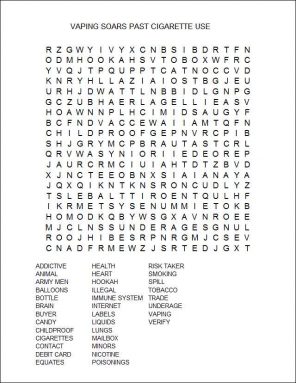Teen vaping soars past cigarette use
Although nearly every U.S. state bans sales of vape products to minors, kids can easily buy them online
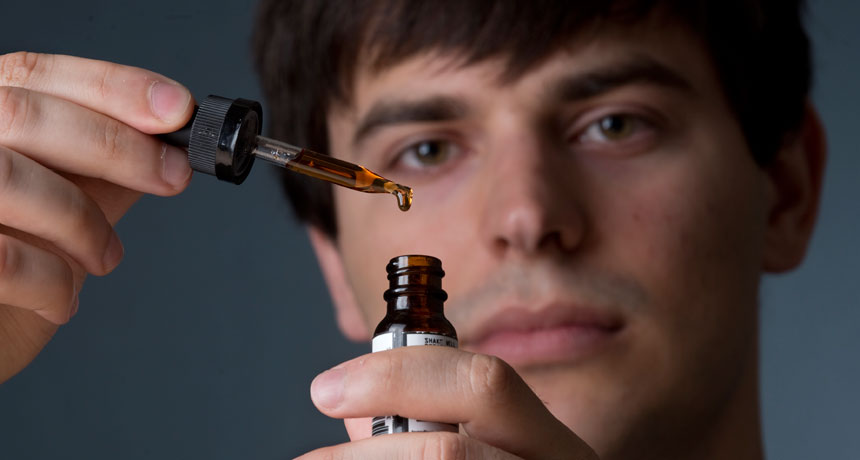
The hit of nicotine that vapers get from each puff on an e-cigarette comes from liquids they vaporize through the device. Watch out: Some small bottles of these liquids contain enough nicotine to kill an adult.
Steve Zylius / UCI
By Janet Raloff
In 2013, nearly three times as many U.S. high school kids smoked as puffed on electronic cigarettes. Within two short years, that trend has reversed. Today, almost twice as many high school kids vape as smoke, a new study finds. Middle-school students have an even stronger preference for vaping over smoking.
Tushar Singh works in the Office on Smoking and Health at the Centers for Disease Control and Prevention (CDC) in Atlanta, Ga. He and his colleagues analyzed data collected across the nation between 2011 and 2015 as part of the National Youth Tobacco Survey. These data show that an estimated 16 percent of high school kids vaped in 2015. That adds up to 2.39 million teens. By comparison, just 1.37 million high school kids smoked cigarettes.
Overall, last year, one in every four high-school students and more than one in every 14 students in middle school used some form of tobacco products. And yes, e-cigarettes are considered a tobacco product. The fluid or e-liquid that they heat up to create their vapors contains nicotine. It’s the chemical in tobacco leaves that makes tobacco so stimulating to the brain — and so addictive.
Singh’s team shared its new findings April 15 in Morbidity and Mortality Weekly Report.
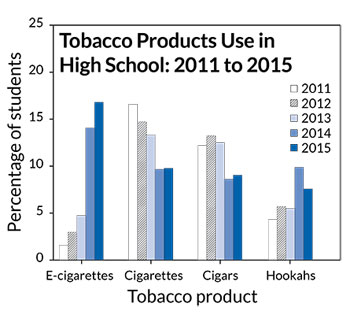
Since 2011, U.S. teens have been smoking fewer cigarettes, cigars and pipes. They also have used less chewing tobacco. The only tobacco products to buck this trend have been e-cigarettes and hookahs, or water pipes (although even hookah use has dropped since 2014). Still, over the past five years, the number of young people using tobacco products has not dropped. The growing rate of vaping seems to be what’s keeping teen “tobacco” use stable.
What’s more, teens who vape may smoke, too. A study released in January found that nonsmoking teens who start vaping are three times as likely as nonvapers to later smoke cigarettes. What’s more, vaping seemed to encourage smoking, the study found. This was true even for teens who weren’t rebellious or risk-takers and would have seemed the least likely to start smoking.
Surveys have shown that many kids experiment with e-cigarettes. Most assume vaping is harmless. It is not. Over the past four years, studies have shown that the gases and particles in e-cigarette vapors can harm the lungs, brain, heart and immune system (which helps us resist infections). Emerging data show that these vapors may even harm the male reproductive system. Some health risks from vaping almost seem worse than those from smoking, according to February reports on data from animals and from human cells.
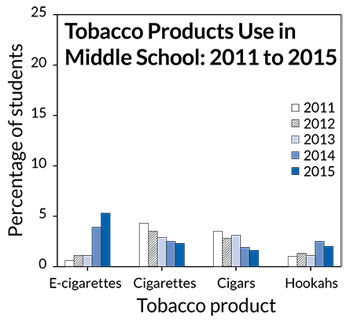
Worried about the rapid growth in e-cig use by teens, at least 48 U.S. states have banned the sale of vaping supplies to minors — people under the age of 18 or 19. The other states made it illegal to share vaping products with minors. These stats come from the National Conference of State Legislatures. And they show that all states are actively working to keep e-cigarettes out of the hands of minors.
Yet those “minors do not face any significant barrier in purchasing liquid nicotine over the Internet” for use in electronic cigarettes. That’s the finding of a second new study.
Minors have no trouble getting vape supplies
Dmitriy Nikitin works at the University of California, Irvine. Last summer, he and his colleagues recruited three teens to contact 120 different U.S. online stores that sell vaping products. The researchers provided money so that the 16- and 17-year olds could attempt to buy bottles of e-liquids.
Despite the 50-state ban on teen access to vaping products, all but four of the stores sold e-liquids to the teens.
“I was really blown away by the results,” Nikitin says. Only “a handful” of stores did anything to verify that the kids were old enough to legally buy vaping supplies. So if kids want to buy these goods, he says, they will most likely succeed.
Nikitin’s group had given each teen a list of companies to contact. They wanted to make sure these reflected the range of online stores that sell vape supplies.
Half of the e-liquid sellers belonged to a trade association. That’s a group of companies that work in the same field. Each e-cig trade group had promised its members would not sell vape supplies to minors. Yet in the new study 58 of the 60 companies belonging to such groups did.
Nikitin and his colleagues published their findings online April 1 in Nicotine & Tobacco Research.
Vaping liquids may be flavored to taste like fruit, candy or other foods and beverages. More importantly, most contain nicotine. And that last ingredient can make the liquids poisonous, even before they are heated in an e-cigarette.
High concentrations of nicotine can kill. Many e-liquid containers, even small ones, have enough nicotine to kill an adult. When dissolved in a solution, that nicotine can enter the body directly through the skin. So accidental spills may prove toxic.

And young kids may be tempted to taste any liquid sold in a bottle with pictures of fruit, candy or ice cream on its label. Poison-control agencies have been fielding lots of calls about e-cig poisonings. Many of the victims are preschoolers.
These health risks explain one goal of the new study. Nikitin’s team wanted to see whether e-liquids sold online carry warning labels about risks. The scientists also wanted to see whether the bottles had child-proof caps.
The teens therefore brought to the lab all of the e-liquids they successfully bought. There, Nikitin’s group checked for warning labels and safety caps. In all, “90.3 percent of bottles noted that they contained nicotine.” Still, the study found, “only 53.9 percent made any mention of a health warning associated with nicotine use.” The good news: Nearly nine out of every 10 e-liquid bottles had a child-proof cap.
Teens didn’t lie — much — to get the products
Researchers watched every step as the kids had shopped. The students used their own names, addresses and debit cards (not their parents’ cards). Each teen attempted to buy a fruit-flavored e-liquid in a small container.
When the companies asked how old a buyer was, each teen gave a false birth date. It would make them seem to be at least 21 years old. But if a seller asked to see a driver’s license, the teens showed their real ones. In one case, a company then stopped a sale when it realized the buyer was underage.
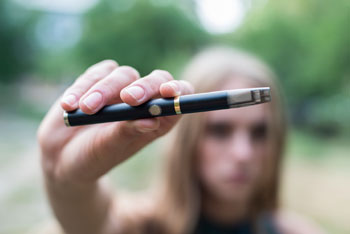
Three stores used special software to verify an online buyer’s age. That software checked whether the names and addresses matched up to some adult. If it didn’t, those sellers halted the sale. This kind of computerized age verification clearly works, Nikitin and his colleagues now conclude. However, they add, almost no online stores appear to use it.
Although the online stores were not supposed to sell to minors, they did seem interested in attracting underage buyers, Nikitin says. Why else, he asks, would some of the purchased e-liquids arrive in the mail with such bonus materials as toy frogs, stickers, bracelets, little green army men or balloons? Or candy such as Mike and Ike, SweeTarts or Laffy Taffy?
Rebecca Williams of the University of North Carolina in Chapel Hill was an author of the new study. She also led a related study last year. In that earlier one, 10 North Carolina students — each 14 to 17 years old — tried to buy e-cigarettes or vaping “starter kits” online.
The kids’ home state was particularly important here. North Carolina is one of the few to require that online stores verify proof of age before selling vaping supplies. Yet of the 98 attempted purchases, the teens were able to get e-cigs delivered to their home 75 times. And although a few online stores claimed they would have shippers verify a buyer’s age at the time of delivery, none did. Packages were simply left at a buyer’s door or in the mailbox.
So why do kids vape?
Another new study now links the likelihood a teen will vape with e-cigarette advertising. Singh and his colleagues at the CDC used data collected from 22,007 U.S. kids in 6th to 12th grade. They came from the 2014 National Youth Tobacco Survey. Tweens and teens who reported having seen ads for e-cigarettes were more likely to have tried vaping, it showed. The link was strongest for those who saw those ads online or in local stores. High school students who saw ads in these places were almost twice as likely to vape as those who saw no e-cigarette ads. Middle school kids who saw ads in these places were more than twice as likely to have vaped.
The CDC team described its findings early online April 25 in Pediatrics.
Williams and her co-authors conclude: “Federal law should require rigorous age verification for all e-cigarette sales.” Until it does, minors will have little trouble getting access to e-cigarettes — and thus will risk becoming addicted to nicotine.
Power Words
(for more about Power Words, click here)
addiction (adj. addictive) The uncontrolled use of a habit-forming drug or uncontrolled and unhealthy habit (such as video game playing or phone texting). It results from an illness triggered by brain changes that occur after using some drugs or engaging in some extremely pleasurable activities. People with an addiction will feel a compelling need to use a drug (which can be alcohol, the nicotine in tobacco, a prescription drug or an illegal chemical such as cocaine or heroin), even when the user knows that doing so risks severe health or legal consequences. (For instance, even though 35 million Americans try to quit smoking each year, fewer than 15 out of 100 succeed. Most begin smoking again within a week, according to the National Institute on Drug Abuse.)
cell The smallest structural and functional unit of an organism. Typically too small to see with the naked eye, it consists of watery fluid surrounded by a membrane or wall. Animals are made of anywhere from thousands to trillions of cells, depending on their size. Some organisms, such as yeasts, molds, bacteria and some algae, are composed of only one cell.
Centers for Disease Control and Prevention, or CDC An agency of the U.S. Department of Health and Human Services, CDC is charged with protecting public health and safety by working to control and prevent disease, injury and disabilities. It does this by investigating disease outbreaks, tracking exposures by Americans to infections and toxic chemicals, and regularly surveying diet and other habits among a representative cross-section of all Americans.
debit card A plastic card that can be used in place of money. But unlike a credit card, which borrows money from a bank (or related lending institution) with each transaction, the debit card is used like a check. Each transaction with it uses up some of the money that already exists in someone’s bank account.
e-cigarette (short for electronic cigarette) Battery-powered device that disperse nicotine and other chemicals as tiny airborne particles that users can inhale. They were originally developed as a safer alternative to cigarettes that users could use as they tried to slowly break their addiction to the nicotine in tobacco products.
e-liquid A term for the solutions heated to the evaporation point in an electronic cigarette. These solutions are the basis of the vapors that will be inhaled. The liquid typically contains a solvent into which flavorings and nicotine have been dissolved.
hookah A water pipe used to cool smoke — usually tobacco smoke — that will be inhaled. According to the U.S. Centers for Disease Control and Prevention, “hookah smoking carries many of the same health risks as cigarettes.”
immune system The collection of cells and their responses that help the body fight off infections and deal with foreign substances that may provoke allergies.
infection A disease that can spread from one organism to another.
minors Children and adolescents below an age that would make them legally adults.
morbidity The prevalence of illness; the share of people having a particular sickness at some particular time or in some particular place.
mortality Deaths. From mortal, meaning deadly.
nicotine A colorless, oily chemical produced in tobacco and certain other plants. It creates the ‘buzz’ effect associated with smoking. It also is highly addictive, making it hard for smokers to give us their use of cigarettes. The chemical is also a poison, sometimes used as a pesticide to kill insects and even some invasive snakes or frogs.
software The mathematical instructions that direct a computer’s hardware, including its processor, to perform certain operations.
tobacco A plant cultivated for its leaves. Dried tobacco leaves are burned in cigars, cigarettes, and pipes. Tobacco leaves are also sometimes chewed. The main constituent of tobacco leaves is nicotine.
toxic Poisonous or able to harm or kill cells, tissues or whole organisms. The measure of risk posed by such a poison is its toxicity.
trade association A group formed of people or companies that have a shared commercial interest. Trade, as used here, refers to selling things for money. So these groups represent people who tend to sell or care about the same things — from peanuts and shoes, to cars, property and steel.
vaping (v. to vape) A slang term for the use of e-cigarettes because these devices emit vapor, not smoke. People who do this are referred to as vapers.
vapors Fumes released when a liquid transforms to a gas, usually as a result of heating.
verify (n. verification) To demonstrate or confirm in some way that a particular claim or suspicion is true.
Word Find (click here to enlarge for printing)
